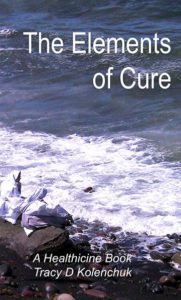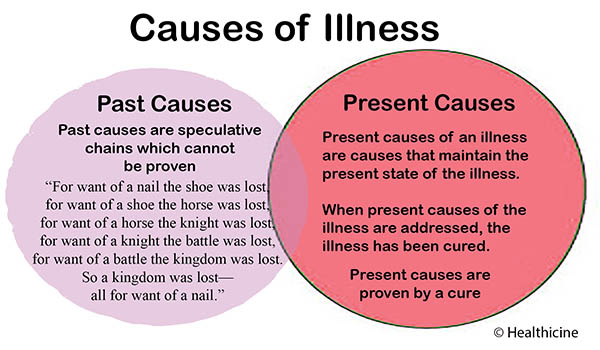Every illness and every disease has two types of causes, only one of which cures.
Every illness has Past Causes
Epidemiological researchers speculate, it seems, that everything causes cancer. Even the simplest diseases, like scurvy – easily cured in theory – can have many different past causes. Past causes causes are speculative, sometimes long complex chains of possible cause, like the famous example: “for want of a nail... the kingdom was lost“. Studying past causes is useful for prevention, but not to cure.
We cannot address past causes, because they are in the past. We cannot prove that any past cause was a real cause in a specific case.
We study past causes to prevent illnesses. However, because past causes cannot be proven, all preventatives are speculative. It is difficult to determine how many illnesses have been prevented by any action.
Notice the overlap in the diagram. Sometimes, a past cause is also a present cause – but these cases are few. Why? Every illness, every case of illness has one present cause. When a case of illness has two or more present causes, both causes must be addressed to cure. The illness is compound, consisting of two or more illness elements. Every simple illness, with a single cause, has many past causes – only one of them can sometimes be a present cause.
Every illness has Present Causes
Present causes are those causes that are and maintain the illness. Without them, the illness disappears. It is cured.
A case of illness is cured by addressing its present cause.
A Cure Proves a Cause
When an illness is cured, the cause has been addressed. It might have been addressed by a medicine. Most illnesses are cured by healthiness. “There is no cure for the common cold.” When an illness is cured by healthiness – we don’t know what happened, unless we took intentional actions to improve healthiness.
When we take any action to address the present cause of an illness, and the illness is cured, the cure proves the cause. We might be wrong, many simple changes can address causes without our awareness. But a cure is the best proof of a cause and there is no other proof. Let’s look at some simple examples.
Infections
An infection might have many past causes. An infection might be attributed to:
- unsanitary conditions
- a wounld left open
- unhealthiness, like a tooth infection caused by gingivitis, or infections in bedsores caused by lack of exercise
- exposure to a dangerous parasite
These are past causes. When the cause is present, the infection can occur. Avoiding these causes prevents many infections. However, once the infection occurs, the past causes are not as important as the infection. The infection must be cured.
The Mayo Clinic says the following causes of infections: “Infectious diseases are disorders caused by organisms — such as bacteria, viruses, fungi or parasites.”
These are present causes. Once the infection is present, the present cause must be addressed.
An infection is specific. We rarely have infections of many different kinds of bacteria, viruses, fungi and parasites at one time. An infection, a single case of an infection is an infection of a single type of bacteria, virus, fungi, or parasite. The cure is to address the present cause of the specific case. Preventative activities might avoid more infections, even when an infection is present, but they address potential causes, past causes, and cannot cure.
Most infections are cured by health. The Mayo Clinic advises “Many organisms live in and on our bodies. They’re normally harmless or even helpful. But under certain conditions, some organisms may cause disease.”
The Common Cold
The common cold is a simple infection with no medical cure. The viruses that cause a cold might be constantly present in our environment, but we don’t get a cold. Researchers find that even swabbing the virus inside healthy student’s noses does not cause a cold. Why not? Our bodies, our minds, our spirits, and our communities are very good at addressing past causes of the common cold.
Then, sometimes, we get a cold.
What was the cause of cold? Was it
- walking in the rain (a past cause)?
- failure to wear a sweater in the cold (a past cause)?
- exposure to many young children with many different colds (a past cause)?
- was it caused by exposure to a specific cold virus (past cause)?
- unhealthiness of the body, allowing the virus to multiply (past and present cause)?
If we want to prevent illnesses, these causes can be important. But when we need to cure an illness, most of them fail to cure.
To cure, we need to ask a different question, not what WAS the cause,
What IS the present cause?
The present cause of a case of the cold is specific. A specific case of an infection with a specific cold virus. How might we cure a case of the common cold?
We can cure some infections with poison, killing the infectious agent listed by the Mayo Clinic. We can cure tapeworm infections and many bacterial and fungal infections with a poison that kills the parasite.
But not the cold. Why can’t we cure the common cold with medicines?
- There are hundreds, possibly thousands of viruses that cause the common cold. Taking hundreds of medicines at once, is a dangerous treatment.
- viruses are not alive. We can’t kill them.
Thus, “There is no cure for the common cold,” the nonsense of medical chauvinism.
I’ve had many colds. You probably had a few colds last year. They were cured. How is the common cold cured? By health.
Our bodies and our immune systems are very good at curing the common cold. But they don’t kill the virus. What do they do? They address present causes, some of which might also be past causes.
Our bodies know that if cells are healthy, they are less likely to be infected by the common cold. So our bodies, minds, spirits, and communities work hard to prevent infections like colds – by staying healthy. Common colds can be caused by:
- unhealthy cells exposed to a virus (a past cause)
When a cell is infected by a cold virus, it becomes damaged and dies. This is the present cause of a cold. When the cell dies, the virus that infected it multiplies and spreads out to infect new unhealthy cells.
Our body identifies present causes of the common cold:
- damaged cells
- infected cells
- viruses at the infection site
Our immune system cleans up. It eats the viruses, it eats the infected and damaged cells. Our immune system is like a set of powerful intelligent nanobots, that sees the virus infection growing, identifies the virus as the present cause and the infected cells that are also a present cause, and eats them. Then it moves what is eaten off to be excreted. We sneeze. The virus uses the sneeze as a pathway to infect others. Our bodies use the sneeze to get rid of the infection.
Most symptoms of a common cold are not from the virus. Most are from our immune system. Attempts to “cure” the symptoms of the common cold make use feel better about the actions of immune system nanobots, but most don’t help the cure.
The cure is health. Most infections are cured when our healthiness addresses the present cause. Let’s look at a different type of infection.
Wound Infection
Wound infections or skin infections have a similar list of causes. We might get an infection because:
- we failed to protect a cut (past cause)
- we failed to wash our hands (past cause)
- we failed to use the knife carefully (past cause)
- our is unhealthy, dry, or dirty (past and present cause)
Addressing past causes cannot cure. To cure in infection we need to address the present cause.
The present cause of an infection might be a growth of bacteria or a fungus in a wound. How are most infections cured? By health. Our healthy immune systems kill many infectious agents. Our healthy minds, bodies, spirits, and communities protect us as the infection heals. Most infections are not very dangerous to a healthy person. Sometimes, an infection becomes dangerous, possibly even deadly, and more drastic actions – medical actions are necessary.
How does a medical treatment cure an infection? By addressing the present cause. Many dangerous infections are cured by antibiotics. Some are cured by surgery, surgically removing the infected tissue.
Summary
 This post is based on the concepts published in the book: The Elements of Cure. There are many ways to prevent illness, but few of them cure. Preventative actions address potential causes, past causes, when there is no present illness.
This post is based on the concepts published in the book: The Elements of Cure. There are many ways to prevent illness, but few of them cure. Preventative actions address potential causes, past causes, when there is no present illness.
When an illness is present, it is necessary to address the present cause to produce a cure. This is true of all illnesses.
to your health, tracy
Author: The Elements of Cure



